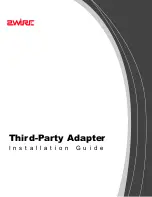
Software
Crestron
e-Control
®
computers than there are available IP addresses. DHCP supports static addresses for
computers containing Web servers that need a permanent IP address.
DMZ
- (
D
e
M
ilitarized
Z
one) allows one IP address (or computer) to be exposed to the
Internet. Some applications require multiple TCP/IP ports to be open. It is
recommended that you set your computer with a static IP address if you want to use
DMZ Hosting.
DNS
- The Domain Name System (DNS) is the way that Internet domain names are
located and translated into Internet Protocol (IP) addresses. A domain name is a
meaningful and easy-to-remember “handle” for an Internet address. Every domain has
a domain name server that responds to each request. Requests originate from programs
and other name servers. Either way, the server converts domain names into IP
addresses if the request is accepted. If the request is not accepted, the name server can
contact other name servers, offer the IP address for a name server that might complete
the request, or return an error message stating that the requested domain name is
invalid or does not exist.
Domain
- A sub-network comprised of a group of clients and servers under the control
of one security database. Dividing LANs into domains improves performance and
security.
Download
- To receive a file transmitted over a network. In a communications session,
download means receive, and upload means transmit.
Driver
- A workstation or server software module that provides an interface between a
network interface card and the upper-layer protocol software running in the computer;
it is designed for a specific NIC, and is installed during the initial installation of a
network-compatible client or server operating system.
Dynamic IP Address
- An IP address that is automatically assigned to a client station
in a TCP/IP network, typically by a DHCP server. Network devices that serve multiple
users, such as servers and printers, are usually assigned static IP addresses.
Dynamic Routing
- The ability for a router to forward data via a different route based
on the current conditions of the communications circuits. For example, it can adjust for
overloaded traffic or failing lines and is much more flexible than static routing, which
uses a fixed forwarding path.
Ethernet
- IEEE standard network protocol that specifies how data is placed on and
retrieved from a common transmission medium. Has a transfer rate of 10 Mbps. Forms
the underlying transport vehicle used by several upper-level protocols, including
TCP/IP and XNS.
Fast Ethernet
- A 100 Mbps technology based on the 10Base-T Ethernet CSMA/CD
network access method.
Firewall
- A firewall is a set of related programs, located at a network gateway server,
which protects the resources of a network from users from other networks. (The term
also implies the security policy that is used with the programs.) An enterprise with an
intranet that allows its workers access to the wider Internet installs a firewall to prevent
outsiders from accessing its own private data resources and for controlling what outside
resources to which its own users have access.
A firewall, working closely with a router, examines each network packet to determine
whether to forward it toward its destination.
48
•
Crestron e-Control®
Reference Guide – DOC. 6052
















































